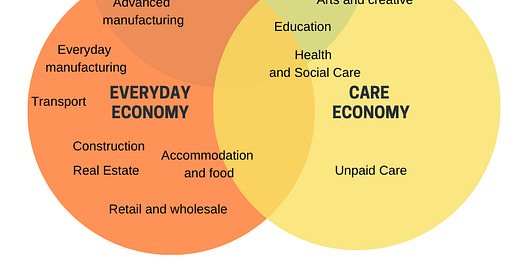A Tale of Three Economies
Why we need a story and strategy for the “caring” and “everyday” economies as well as the “growth” economy
Earlier this week, the Government launched its industrial policy and I remarked that the fact it was focused was good and that also meant the need for a wider strategy and story about non-focus areas. On the back of that consideration I’ve done some number crunching and a very interesting story opens up about the bits of the economy that we don’t anticipate being high productivity growth. Most notably, it encompasses the majority of the economy and most employment. It will also have a bigger footprint outside of the relatively high productivity regions. In other words, it matters enormously.
The Chancellor (then in Opposition), Rachel Reeves MP, outlined her vision of the Everyday Economy a couple of years back, thus:
“The everyday economy is made up of the services, production, consumption and social goods that sustain all our daily lives. Its activities include transport, child care, health, social care, education, utilities, broadband, social benefits and the low-productivity, low-wage sectors of hospitality, retail, food processing and supermarkets.”
There’s a lot in that and the point was a profound one: what is the political economy for those often in less visible industries, jobs, and businesses as we focus attention on sectors like digital, creative, finance and advanced manufacturing that have higher productivity and likely growth? We are talking the work of keeping life functioning on an everyday level after all and, well, that is important.
For reasons that will become apparent, the everyday economy she described may actually cover two distinct but overlapping ways of engaging in economic life - which I define as fulfilling our basic needs and creating value. One is the more visible everyday economy of production, commerce, distribution, and consumption. The other is the caring economy where our social needs and wellbeing are met through health, care, education and cultural life. The former tends to operate through markets. The latter through family, society, and public services. A huge portion of it is unpaid (skewed towards women) and exists beyond the money economy.
And when we separate out “everyday” and “care” alongside “growth” it might roughly look something like this:
It might seem controversial to include unpaid care but why not? It helps people fulfil their needs and creates (social) value. I would actually say that it’s important to include it as the Chancellor rightly did in her Everyday Economy pamphlet, otherwise we miss a huge chunk of national value. The “high growth” bubble above was the focus of the industrial policy green paper earlier this week but what of the other two “economies”?
The Government would say, absolutely with justification, that a raft of other policies from the just published Employment Bill to the youth guarantee to a new NHS ten year plan and social care sector plan are just some of the policies that respond to “everyday” and “care” economy needs. Missions in growth, health, and opportunity further underpin these arenas of social and economic life. The sense still remains that the needs of a competitive retail sector are very different to those of green industries which are very different to the needs of carers and these differences sit within the differing characteristics of growth, everyday and care.
The numbers of those sitting outside of the high productivity sectors is significant. When we include the unpaid care sector (taking an estimate of its value from Carers UK) the three economies look like this in terms of output and employment:
It is as you would expect, the largest positive output to employment gap is in the “growth” economy (signalling higher productivity), about even in the “everyday” economy and negative in the “care” economy. We can remove the “care” economy “output” that I shoehorned in and this pattern is even more stark.
A note of caution with all of this, I have taken the top-level sectors for the purposes of ease and speed. The lower level standard industry codes will shift things around somewhat. But I think these data are useful as broad framing.
The question for the Government going forward, and no hurry as they have a lot on their plate, is whether the current constellation of policies and missions do enough to cohere as a strategy for the “everyday” and “care” economies in terms of their potential contribution not only to economic output but to people and places too. Combined Authority growth strategies, for example, will look lopsided without this wider frame: growth industries, unfortunately, are not evenly distributed.
I recently heard a panel of mayors where there was much focus on the high status sectors in the growth bubble above- digital, green life sciences and so on whether their regions really had a strong base in those sectors or not. One focused on agriculture, a strength of their combined authority area and that felt most plausible as an “everyday” economy strategy. And one focused on the talents and spirit of their people which felt very “caring” economy. The regions will need to focus across the piece even whilst national industrial strategy prioritises growth for entirely understandable reasons.
The industrial strategy was impressive in its explicit choices and goal of productivity growth primarily. A case can be made for building out the story and strategies for “everyday” and “care” also. Over the coming weeks, I’ll return to this framing.







I like your focus on the everyday economy Anthony. Without using that phrase, I like to think it was a focus for our Tees Valley RSA work. In my own Substack I'm focusing on urban planning an design that focuses on enhancing community and local economies. I hope you'll take a look.